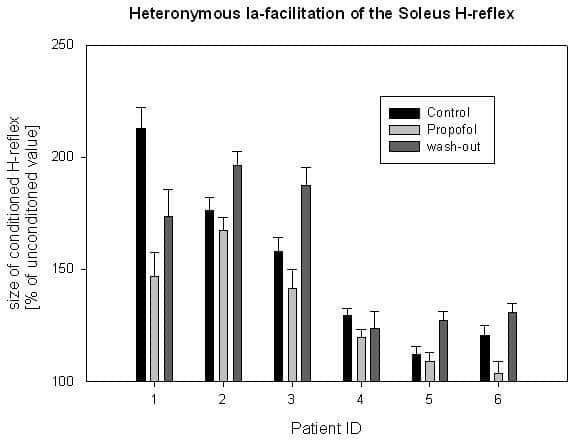In vitro studies performed on spinal slice cultures indicate that the primary molecular targets of Propofol in the spinal cord are GABAA receptors (Grasshoff & Antkowiak, 2004). These receptors might play an important role in the suppression of movement by Propofol. However, until now the importance of GABAergic effects has not been shown in humans. Here we used heteronymous Ia facilitation of the soleus H-reflex from the femoral nerve (Hultborn et al., 1987) as a specific pathway involving GABA to demonstrate the GABAergic effect of propofol in humans. After approval of the local ethics committee, the study was carried out on six volunteers aged 23-32. The subjects received propofol via a target controlled infusion system yielding steady-state plasma concentrations of 2mg/l. This caused a sedative state with a sustained ability to respond to loud verbal commands. The soleus H-reflex was evoked every 6s in the popliteal fossa and was recorded with disc electrodes placed over the soleus muscle. Conditioned and unconditioned reflexes were tested in random order. The stimulation current was adjusted so that the unconditioned H-reflex amplitude was kept at 15% of Mmax, which was determined before each cycle of measurement. The femoral nerve was stimulated through a monopolar ball electrode in the femoral triangle( 1.15xMT). The onset of facilitation was defined as the earliest conditioning-test interval at which the conditioned H-reflex amplitude was at least 5% higher than the test reflex (unpaired T-test p<0.05). Throughout the study the conditioning stimulus was applied 0.5 ms after this onset, which was determined in steps of 0.1ms. This procedure assures a facilitation caused by a pure monosynaptic EPSP. Measurements were performed under 3 conditions: a) prior to propofol administration (control) b) during steady-state propofol administration c) 35min after propofol infusion was stopped. During each condition a recruitment curve of the H-reflex amplitude was established. The mean reduction of Hmax/Mmax by propofol yielded 25% ± 15%(mean± SD)in comparison to the control values. In all but one subject soleus H-reflex facilitation was reduced significantly by propofol (t-test, p<0.01, see figure). Facilitation recovered significantly in all subjects after discontinuation of propofol. The results show that Propofol reduces heteronymous Ia facilitation of the soleus H-reflex from the femoral nerve. By adjusting the unconditioned reflex to control values before Propofol administration, this effect must be mediated by increased presynaptic inhibition on Ia afferent fibers, a specific GABAergic effect.
University of Bristol (2005) J Physiol 567P, PC201
Poster Communications: Propofol enhances GABAergic presynaptic Ia-inhibition in humans
Baars, Jan Harald; von Dincklage, Falk; Reiche, Josephine; Rehberg, Benno;
1. Department of Anaesthesiology, Charite Campus Mitte, Berlin, Germany.
View other abstracts by:
Where applicable, experiments conform with Society ethical requirements.

